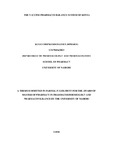| dc.contributor.author | Kugo, Chepkemboi Linet | |
| dc.date.accessioned | 2016-11-22T07:19:53Z | |
| dc.date.available | 2016-11-22T07:19:53Z | |
| dc.date.issued | 2016 | |
| dc.identifier.uri | http://hdl.handle.net/11295/97675 | |
| dc.description.abstract | Background: Vaccines are biological products which are used to produce or enhance immunity against vaccine preventable diseases (VPDs). Public confidence in vaccines is critical to the success of any immunization programme. For a National Immunization Programme (NIP) to achieve high and sustained population coverage, the vaccines have to be perceived as being very safe by a majority of the population. The main aim of having a functional system for pharmacovigilance of vaccines is to facilitate early detection and analysis of adverse events following immunization (AEFI) and quick and appropriate response in order to minimize negative impact to the NIP and to the health of individuals.
Study objectives: The main objective of the study was to assess the Kenyan vaccine pharmacovigilance system. The specific objectives of the study were to analyse policy, law and regulations governing vaccine pharmacovigilance in Kenya; to assess the systems, structures and stakeholder coordination for vaccine pharmacovigilance; to determine signal generation and data management in vaccine pharmacovigilance; to assess risk assessment and evaluation in pharmacovigilance of vaccines; and to analyse risk management and communication in pharmacovigilance of vaccines.
Study design: A descriptive cross-sectional study was conducted. Ten key informants from the Pharmacy and Poisons Board (PPB) and the Unit of Vaccines and Immunization Services (UVIS) were selected based on purposive sampling. Data were collected using the Indicator-based Pharmacovigilance Assessment Tool (IPAT), a metric instrument designed and validated by Management Sciences for Health (MSH). The evaluation also involved review of relevant vaccine pharmacovigilance documents in the institutions assessed. A scoring system was used to quantify assessment results.
Study site: The study was carried out at the Pharmacy and Poisons Board (PPB) and the Unit of Vaccines and Immunization Services (UVIS).
xv
Data analysis: Microsoft Excel was used to compute scores. For computation purposes, 2 points were awarded for each core indicator attained, 1 point for each supplementary indicator attained and 0 points when an indicator was not attained.
Results: The score in the area of policy, law and regulations was 50%. Lack of specific laws dedicated to pharmacovigilance and non-involvement of MAHs in post-marketing activities were the main weaknesses identified. Systems, structures and stakeholder coordination scored 24%. The basic structures of vaccine pharmacovigilance were not in place and there was insufficient coordination of stakeholders in the country. The score for signal generation and data management was 40%, risk assessment and evaluation scored 25%, while risk management and communication scored a paltry 12.5%.
Conclusion: Kenya had a system for pharmacovigilance of vaccines in place. The National Regulatory Authority (represented by PPB) and the National Immunization Program (represented by UVIS) were the institutions responsible for pharmacovigilance of vaccines at the national level. There were staffs assigned to carry out vaccine pharmacovigilance activities and a reporting tool for adverse events following immunization (AEFI). However, some gaps such as absence of specific legislation, lack of guidelines and absence of an organizational structure for vaccine safety were identified. These resulted in poor coordination of vaccine pharmacovigilance activities. These shortcomings hamper the ability of the country to effectively detect and manage vaccine safety issues.
There is need for the revision of the existing medicines legislation to incorporate elements of pharmacovigilance. It is also important to set up organizational structures with clear reporting lines for vaccine pharmacovigilance in order to improve vaccine safety monitoring in the country. | en_US |
| dc.language.iso | en | en_US |
| dc.publisher | University Of Nairobi | en_US |
| dc.rights | Attribution-NonCommercial-NoDerivs 3.0 United States | * |
| dc.rights.uri | http://creativecommons.org/licenses/by-nc-nd/3.0/us/ | * |
| dc.title | The Vaccine Pharmacovigilance System Of Kenya | en_US |
| dc.type | Thesis | en_US |
| dc.description.department | a
Department of Psychiatry, University of Nairobi, ; bDepartment of Mental Health, School of Medicine,
Moi University, Eldoret, Kenya | |



